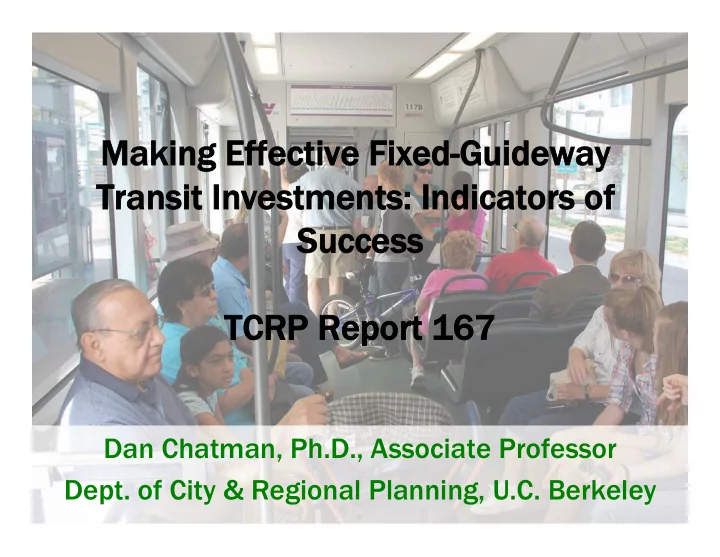

Making E Effective F Fixed-Gu Guidewa eway Transit I Investments: I Indicators o of Su Success ess TCRP R Report 1 167 Dan Chatman, Ph.D., Associate Professor Dept. of City & Regional Planning, U.C. Berkeley
Othe her a autho hors Robert Cervero Don Emerson (PB) Emily Moylan [now at UNSW] Ian Carlton [now at U OK] Dana Weissman [now at F&P] Joe Zissman [now at CS] Erick Guerra [now at U Penn] Jin Murakami [now at CU Hong Kong] Paolo Ikezoe [now at SF planning]
Int Introduct roduction ion • Urban rail and BRT lines are among the largest urban infrastructure investments • Investment decisions therefore justify careful decision making • Different kinds of initial information may be helpful in narrowing down a longer list of options
Project p purpose • The goal was to develop a method to predict project success based on the conditions in the corridor and the metro area • The project was partly intended to define success measures – In the end, we used project ridership, change in transit usage, and capital cost
Goals o of t the he “ “indicator-based metho hod” • Indicators are characteristics of a corridor and a proposed project that may affect the project’s ridership, net PMT, and cost • The method is meant to provide a simplified way to analyze the potential success of a proposed project in a particular corridor • Could be useful for conducting an initial evaluation of corridors and service alternatives
Previous a applications o of i indicator- based m metho hods • Planners have used indicator-based methods to evaluate transit opportunities for many years • Our method generates estimates of project ridership and change in system-level patronage based on statistical analysis, using data from 55 fixed-guideway systems built over the last 40 years.
Case s studies • Diverse transit projects in six metropolitan areas to gain an understanding of how transit planning decisions had been made • We (i.e., Ian Carlton) identified almost 20 different “rules of thumb” used by planners to choose projects or alignments
Recommend
More recommend